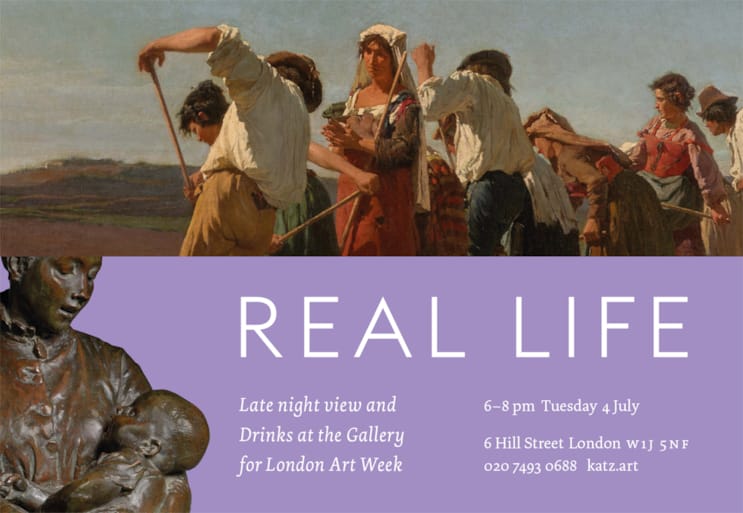
REAL LIFE
From 29 June to 14 July 2023
REAL LIFE: London Art Week
Dates: 29th June - 7th July
Opening Hours: Mon-Fri 9:30-6pm
Social Realism was a term coined to highlight the artistic interest in the social hardships of the period between the two World Wars, with Artists turning to realism as a way of making art easily accessible and legible to the wider public. They often portrayed their subjects—including well-known figures and anonymous everyday workers—as heroic symbols of persistence and strength in the face of adversity.
However, this gallery show delves deeper, spanning works from the 18th, 19th, and early 20th century in an attempt to explore the evolution of the artistic representation of society prior to the inter-war period, and to show how elements of this movement were already established in European art.
As early as the 18th century artists such as Poncy were already laying the foundation for social realism with their newfound inspiration in nature and the world around them. To the modern eye Poncy’s spectacularly realistic portrayal of a goat in an atmospheric setting may seem rather peculiar. However late 18th century Enlightenment in France had led to a newfound understanding of, and interest in, the natural world - as never seen before. Born out of this, the Romantic movement led artists to believe in their freedom of choice, and a desire to render with precision, and clarity the beauty in the everyday.
Meanwhile in Britain, Romantic artists such as John Linnell were combining this newfound interest in representing the beauty of the natural world with a pointed social commentary. By juxtaposing the beauty of nature with the struggles of the working class, he conveyed a sense of contrast and commented on the impact of society on the natural world.
The advent of photography undoubtedly played a large part in the rise of documentation of the human condition and this show includes three early photographs by pioneering 19th century Scottish photographers Robert Adamson and David Octavius Hill. Pushing the boundaries of the new medium they demonstrated both its artistic and documentary power, capturing people and scenes from their surrounds in Edinburgh.
At about the same time, the realist movement in painting, spearheaded by French artists Gustave Courbet and Jean-François Millet, would take centre stage with unflinching portrayals of the working class and rural life - spreading across Europe and focusing the minds of most young artists. Ramón Tusquets y Maignon’s early masterpiece of Spanish Realist painting answers Courbet and Millet’s call. With arresting skill, Tusquets combines beauty, harmony, light, colour and naturalism with the hard-hitting narrative of the peasant workers; resolute in their work on the land under the hot sun. Cleverly composed, the group of figures are imbued with a religious sentiment with the central figure, a lady in prayer, appearing like a vision of the Virgin Mary.
Moving into the late 19th century artists were beginning to capture the emerging new urban realities and the effects of industrialization on society. One of the best artists to capture the nuanced sentiment of this modern life was the sculptor Jules-Aime Dalou. This show includes two works by him on the subject of maternity, in different mediums they are both expertly crafted, highlighting perfectly his perceptiveness for subject and medium and his unpretentious realism.
Finishing with Christopher Wood’s masterpiece of Drying Sails, Mousehole and John Piper’s mesmerising exploration of colour and line, these Neo-Romantics return to develop ideas first explored by artists such as John Linnell one hundred years previously. However, this time the intent is more mystic and primitive, and playful, using bold colour and strong forms to whimsically imbue their scenes with a sense of nostalgia and a longing for a simpler way of life.
Together, these artworks offer visitors to the exhibition a fascinating visual narrative, highlighting the evolution of social realism across three centuries and underscoring the artists' desire to depict and critique the realities of their respective societies.
VIEW WEBSITE
selected works






